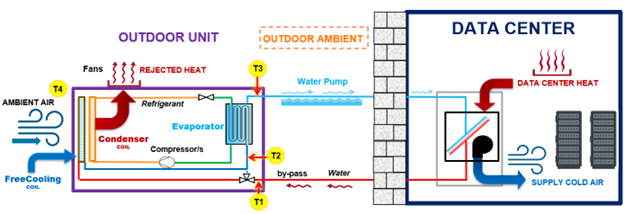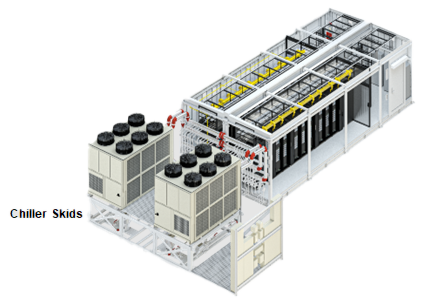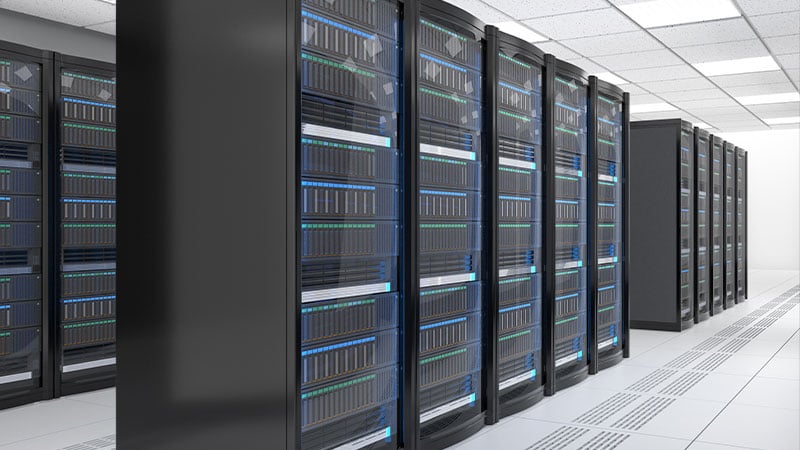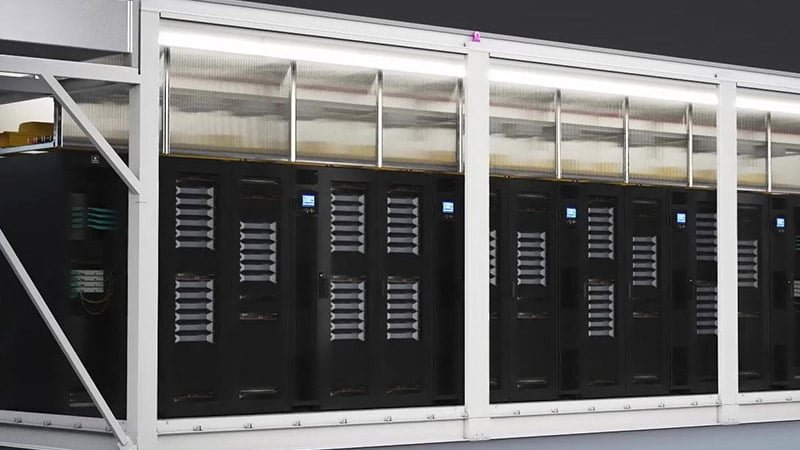Driven by advancements in AI, edge computing, and the Internet of Things (IoT), modular data centers have emerged as a critical component in the successful operations of many companies. The increasing dependence on computing has made the limitations of traditional stick-built data centers more apparent. These drawbacks include inflexibility, inefficiency due to oversizing, and high costs associated with on-premises trade work.
The demand for more critical power, flexible cooling options, and immediate IT capacity has also evolved. Today, a traditional data center with 60-100kW and 10-12 racks may no longer suffice, underscoring the importance and relevance of modular data centers capable of meeting the dynamic needs of businesses today. Enterprises may consider prefabricated modular solutions (PFM) and chilled water systems as more suitable options amid these challenges.
Adapting to High-Density Computing with chilled water systems
Thermal management is an essential pillar of operational data center success. Effective thermal management not only ensures equipment reliability but also addresses concerns, such as cost control, operational saving, and environmental sustainability.
In the past, data center thermal management was dominated by direct expansion (DX) cooling units, also known as computer room air conditioners or CRAC units. These units remove heat from the air through a vapor compression cycle. However, the market is now seeking alternative solutions that offer enhanced operational and energy efficiency, such as chilled water systems.
Understanding chilled water systems
Chilled water systems replace air with water for cooling purposes. These solutions are also vapor compression-based but often include free-cooling functionality and achieve higher overall efficiency via more extensive, centralized components outside the whitespace.

Figure 1. Diagram of a chilled water system
In a chilled water system, the refrigerant is stored in chiller units with a pre-tested circuit to prevent leaks. Monitoring systems can detect leaks during operation, helping to prevent refrigerant loss. Chilled water systems can use other refrigerants with a more limited impact on the atmosphere, including hydrofluoroolefin (HFO) and HFO-blended refrigerants.
Advantages of chilled water systems
Chilled water systems present several comprehensive advantages, positioning this solution as a primary global cooling technology for data centers in the foreseeable future. These advantages include their inherent large-scale efficiency, ability to leverage cooler ambient air temperatures for free cooling and reduced environmental footprint through eco-friendly refrigerants. Such features enhance operational capabilities and align with global sustainability goals, making chilled water systems a strategic choice for future-focused data center operations.
Reduced carbon emissions
Chilled water systems can reduce direct emissions using low-global warming potential (GWP) refrigerant types, such as HFO. To illustrate the environmental benefits of these refrigerants, examine their effects on two prevalent chiller types:
- Small and medium data center chillers, traditionally using R410A (GWP 1924), now offer alternatives like R454B (GWP 466), R32 (GWP 677), or natural refrigerants like R290.
- Medium and large data centers used to cool their equipment with chillers that have screw or centrifugal compressors, using a coolant called R134a with a GWP of 1300. Now, they're switching to coolants like R513A, with a GWP of 573, or R1234ze, which has a GWP of less than 1, for less environmental impact.
Thus, chilled water systems offer an efficient alternative to conventional cooling methods and lower direct emissions without needing significant investments or alterations to the current data center layout.
Chilled water systems can also reduce indirect emissions by promoting energy efficiency, having the potential to support a partial power usage effectiveness (pPUE) lower than 1.1. With growing concerns about global warming and environmental sustainability, some regions are now mandating adopting such thermal solutions.
Enhanced data center safety and flexibility
Beyond sustainability, the system's design merits attention, particularly considering the flammability concerns surrounding modern refrigerants. Chilled water systems excel by situating the cooling units outside the data center, thus mitigating any type of risks associated with the facility’s flammable refrigerants.
Additionally, chilled water systems offer an inherent flexibility in outdoor cooling unit placement. Devoid of fixed configuration requirements and physical limitations, chilled water systems apply to diverse operational needs.
Improved continuity
More importantly, chilled water systems offer robust continuity measures, leveraging auxiliary cold-water storage tanks to bolster thermal reserves during power outages, ensuring uninterrupted cooling to maintain optimal operating conditions. With these multifaceted benefits, chilled water systems emerge as a reliable and efficient solution to meet the evolving demands of contemporary data center environments.
Chilled water systems can also be used in non-raised floor designs, providing flexibility in adding liquid cooling into existing data centers. This is a new, rapidly emerging requirement for high-density compute needs and that is getting more traction as time passes.

Figure 2. Vertiv™ SmartMod™ Max Chilled Water offering
Preferred option for high-density support
Due to its reliability, scalability, and enhanced heat capacity, chilled water is widely used across various sectors, including telecommunications, government, energy/utilities, security, manufacturing, and science. Chilled water is becoming the preferred cooling method for large-scale and high-performance computing applications.
Conclusion
Data center cooling is fundamental, but we must consider sustainability requirements and evolving customer expectations. With the increase in everyday computing, it is evident that data center environments will not remain uniform. Vertiv™ Chilled Water systems offer a globally standardized approach adaptable to the diverse use requirements of present-day data centers. This adaptability ensures immediate benefits while preserving flexibility for future needs.
White Paper: How chilled water systems meet data center availability and sustainability goals
To gain a comprehensive understanding of how Chilled Water Systems are revolutionizing data center thermal management to achieve unparalleled levels of availability and sustainability, we invite you to read our white paper, "How Chilled Water Systems Meet Data Center Availability and Sustainability Goals." This document discusses the critical role of chilled water systems in developing larger, environmentally friendly data centers that reduce direct and indirect emissions, as measured by the total equivalent warming impact (TEWI) and water usage effectiveness (WUE) metrics.
Discover how these systems are meeting current efficiency benchmarks and adapting to the latest trends in data center design, including transitions to non-raised floor configurations and facilitating the switch to liquid cooling, all while minimizing the ecological footprint. Delve into the essence of modern data center cooling technologies with us and learn how you can contribute to a sustainable future.






